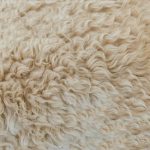If you're considering microfleece for your bedding, you might wonder about its suitability. Known for its softness and warmth, microfleece offers a unique alternative to traditional fabrics. It's lightweight and breathable, but does it come with any downsides? Exploring both the benefits and potential drawbacks could help you decide if microfleece is the right choice for your sleeping environment. Let's look closer at how it stacks up against more common materials you might be familiar with.
Table of Contents
What Is Microfleece?
Microfleece is a soft, lightweight fabric made from polyester that offers cozy warmth and breathability for bedding.
It's crafted through a unique process that involves fine fibers being woven into a dense yet lightweight structure. This results in a fabric that's not only warm but also incredibly soft against your skin.
You'll find that it retains heat without adding bulk, making it perfect for a variety of bedding products.
When you look for microfleece bedding, you'll notice it comes in different thicknesses and textures, allowing you to choose the perfect option for your comfort.
The fabric is generally smooth and has a slight sheen, giving your bedroom a sleek appearance.
Microfleece is also easy to care for; it's machine washable and quick-drying, so you won't have to wait long before it's back on your bed.
Another appealing feature is its hypoallergenic properties, making it suitable for those with allergies or sensitive skin.
Overall, microfleece stands out as a practical choice for bedding, combining functionality with a soft touch that enhances your sleep experience.
Embracing microfleece can elevate your comfort level while you sleep.
Benefits of Microfleece Bedding
When you choose microfleece bedding, you're instantly gaining warmth and comfort without the bulk, making for a cozier sleep environment. The lightweight nature of microfleece allows it to trap body heat while still being breathable, ensuring you don't overheat during the night.
Microfleece is also incredibly soft, creating a gentle touch against your skin that enhances your overall sleeping experience. This luxurious feel might even make getting out of bed more challenging in the morning!
Another major benefit is how easy it's to care for microfleece bedding. It's machine-washable and dries quickly, saving you time and effort when laundry day rolls around. Plus, thanks to its durable fabric, microfleece tends to hold up well over time, resisting fading and wear.
Allergies? No problem! Microfleece is hypoallergenic, making it a great option for those sensitive to dust mites and other allergens. Overall, microfleece bedding combines comfort, warmth, ease of care, and hypoallergenic properties, providing a fantastic sleep environment you can truly enjoy night after night.
Drawbacks of Microfleece Bedding
While microfleece bedding offers many advantages, it's important to consider some drawbacks that might affect your sleep experience.
One major issue is that microfleece can retain heat more than traditional fabrics. If you tend to sleep hot, you might find yourself feeling overheated and uncomfortable, disrupting your rest.
Another concern is the potential for static cling. Especially during the dry winter months, microfleece may generate static electricity, leading to annoying shocks when you get in and out of bed. Some people also find the texture of microfleece to be a bit too synthetic or less breathable, which can affect the overall comfort level.
Additionally, microfleece bedding often requires specific washing and drying instructions to maintain its softness and appearance. Neglecting these guidelines could lead to pilling or a decrease in softness, making it less appealing over time.
Lastly, if sustainability is important to you, keep in mind that microfleece is typically made from synthetic fibers, which may not align with eco-friendly values.
Microfleece Vs. Traditional Fabrics
When comparing microfleece to traditional fabrics, you'll notice key differences in warmth and insulation. Microfleece often traps heat better, keeping you cozy on chilly nights, while traditional materials may offer varying levels of breathability and moisture control.
Understanding these factors can help you choose the right fabric for your bedding needs.
Warmth and Insulation
Microfleece traps heat more effectively than traditional fabrics, ensuring you stay cozy all night long. When temperatures drop, you don't want to compromise on your comfort. Microfleece's unique structure creates tiny pockets of air that retain warmth, making it an excellent insulator. Unlike cotton or linen, which can let heat escape, microfleece keeps you wrapped in warmth, allowing for restful sleep.
You'll notice the difference right away. When you snuggle up in microfleece, it feels soft and warm against your skin. Traditional fabrics may not provide the same level of thermal comfort, leaving you shivering and reaching for extra blankets.
With microfleece, there's no need to layer excessively; you can rely on its insulating qualities to keep you warm. Moreover, microfleece is lightweight, making it easy to handle. It won't weigh you down, unlike heavier blankets that can feel stifling.
You'll enjoy the perfect balance of warmth without sacrificing mobility. So, if you're targeting a snug and comfy night's sleep, microfleece bedding is a top choice. Embrace the comfort and warmth it offers—you'll wonder how you ever slept without it!
Breathability and Moisture Control
Unlike heavier blankets that can trap heat, microfleece effectively balances warmth with breathability, allowing moisture to escape and keeping you comfortable throughout the night. While traditional fabrics like cotton or wool can absorb moisture, they often don't allow it to evaporate as quickly, which might leave you feeling clammy.
Here's a quick comparison of microfleece and some traditional fabrics regarding breathability and moisture control:
| Fabric Type | Breathability | Moisture Control |
|---|---|---|
| Microfleece | High | Excellent |
| Cotton | Moderate | Good |
| Wool | Low | Fair |
| Polyester | Moderate | Good |
Microfleece stands out for its quick-drying properties and lightweight comfort, meaning you won't wake up in a pool of sweat. If you're prone to overheating while you sleep, microfleece is an ideal choice, as it allows you to enjoy wrapped-in warmth without compromising on airflow. When considering bedding materials, microfleece's superior breathability makes it a great option for a cozy yet comfortable night's sleep. You'll appreciate the difference!
Care and Maintenance of Microfleece
To keep your microfleece bedding soft and cozy, it's essential to follow specific care guidelines.
Start by washing your microfleece in cold water on a gentle cycle. Hot water can damage the fibers and compromise their softness. Avoid using bleach or fabric softeners, as these can cause buildup and reduce the fabric's breathability and cuddly feel.
When it comes to drying, skip the high heat as well. Instead, tumble dry on low heat or simply air dry your microfleece bedding. High temperatures can lead to shrinkage and pilling, making your bedding less comfortable.
If you notice any pilling, you can gently use a fabric shaver to restore the smooth texture. Make sure to wash your microfleece bedding separately or with similar materials to prevent friction that can create fuzz and wear.
Lastly, store your bedding in a cool, dry place when not in use. Avoid damp environments, which could encourage mold and mildew. By following these care tips, you'll keep your microfleece bedding in great condition, ensuring it remains a cozy and inviting addition to your sleep space.
Best Uses for Microfleece
When it comes to bedding, microfleece is your go-to for its incredible warmth and insulation without the bulk.
You'll appreciate the softness and comfort it brings to your sleep experience, making every night feel cozy.
Plus, its durability ensures that it'll stand the test of time with minimal care.
Warmth and Insulation
Microfleece excels in providing warmth and insulation, making it an ideal choice for chilly nights and cozy bedding setups. When temperatures drop, you'll appreciate how microfleece traps heat effectively without feeling bulky. Its unique fabric structure allows it to retain warmth while remaining lightweight, which is perfect for ensuring you stay snug without the extra weight.
Using microfleece for your bedding helps create a warm, inviting atmosphere in your bedroom. Consider incorporating microfleece sheets or blankets, as they create a layer of insulation that keeps cool drafts at bay. If you sometimes wake up uncomfortable at night, you'll find that microfleece bedding can help maintain a stable temperature, preventing those annoying temperature fluctuations that can disrupt your sleep.
Microfleece also dries quickly, making it a practical option for those chilly nights when things may accidentally get damp. Whether you're snuggling up for a movie night or settling in for a good night's sleep, this material enhances your bedding experience by ensuring you're warm and comfortable throughout the night. So, embrace microfleece, and enjoy the warmth it offers!
Softness and Comfort
Along with its impressive insulating properties, microfleece also offers an unparalleled level of softness and comfort that makes it perfect for creating a cozy bedding environment. You'll love how this fabric feels against your skin, wrapping you in a gentle embrace each night. The lightweight yet plush texture provides warmth without the bulk, ensuring you stay snug without feeling weighed down.
When it comes to bedding, microfleece brings a luxurious touch. Whether you opt for sheets, blankets, or duvet covers, you're sure to appreciate the tactile experience it offers. Snuggling under a microfleece blanket after a long day is like being enveloped in a warm hug—ideal for chilly nights or lazy mornings.
Additionally, microfleece's breathability means you won't overheat, which is crucial for a restful night's sleep. You can enjoy that soft, cozy feeling all night long, without waking up feeling uncomfortable.
Durability and Care
Microfleece isn't only incredibly soft, but it also boasts impressive durability, making it a smart choice for bedding that withstands everyday wear and washing. It resists pilling and fading, so your sheets, blankets, and pillowcases will maintain their luxurious feel and vibrant color even after multiple washes.
For care, you can easily machine wash your microfleece items. Just toss them in the washer with cold water and a gentle detergent. Avoid using bleach or fabric softeners as they can break down the fabric's fibers over time.
When it comes to drying, a tumble dryer on a low setting works best. You'll want to remove them from the dryer promptly to prevent wrinkling.
Microfleece is perfect for countless uses in your bedding ensemble, whether you're using it for sheets, comforters, or throw blankets. Its lightweight nature makes it user-friendly, ensuring it's cozy without being overly heavy.
With proper care, your microfleece bedding can last for years, providing you with warmth and comfort season after season. It's an excellent investment for anyone looking to enhance their sleep experience.
Customer Experiences and Reviews
Many customers frequently praise microfleece bedding for its exceptional softness and warmth, often noting how it enhances their sleep experience. You'll love how cozy and inviting your bed feels when you add microfleece sheets or blankets. Reviewers often comment on how the fabric retains heat without being overly heavy, making it ideal for chilly nights.
You'll also notice a trend in the feedback regarding easy maintenance. Most customers appreciate that microfleece is machine washable and dries quickly, saving you time and effort in laundry routines. They often highlight that the fabric resists wrinkles and doesn't require much ironing, adding convenience to your bedding care.
That said, some users express concerns about how microfleece can pick up pet hair or lint, so if you've got furry friends, you might want to consider that. Additionally, a few reviews mention that microfleece can feel too warm during hotter seasons, which mightn't suit everyone's preferences. Overall, customer experiences reveal a strong preference for microfleece bedding for its comfort and practicality, making it a popular choice for enhancing sleep quality. You're likely to find it a cozy addition to your bedding collection.
Frequently Asked Questions
Is Microfleece Hypoallergenic for Sensitive Skin?
Microfleece isn't inherently hypoallergenic, but it's generally softer and less irritating for sensitive skin. If you have allergies, you should still check product labels and choose high-quality, breathable materials for the best comfort.
Can Microfleece Be Used for Summer Bedding?
You can definitely use microfleece for summer bedding! It's lightweight and breathable, providing comfort without overheating. Just remember to choose lighter colors and materials if you want to stay cool during those warm nights.
What Is the Lifespan of Microfleece Bedding?
Microfleece bedding typically lasts around three to five years with proper care. You should wash it gently, avoiding harsh detergents, to maintain its softness and durability, ensuring you get the most out of your investment.
Is Microfleece Environmentally Friendly?
Microfleece isn't the most eco-friendly option. While it's soft and warm, it's made from synthetic fibers that shed microplastics in the wash. You might consider alternatives like organic cotton or bamboo for a greener choice.
Does Microfleece Retain Odors Over Time?
Microfleece can retain odors over time, especially if it's not washed regularly. To keep it fresh, you'll want to launder it frequently, using the right detergent to combat any lingering smells effectively.
- How Does Ring Spun Cotton Affect Garment Fit and Shape Retention? - August 13, 2024
- What Are the Challenges in Producing Ring Spun Cotton? - August 13, 2024
- Is Ring Spun Cotton Suitable for Plus-Size Clothing? - August 13, 2024







